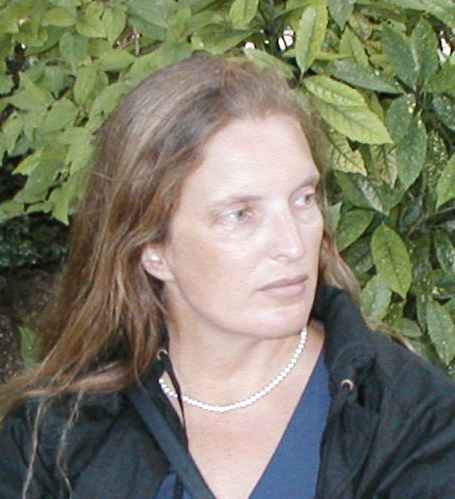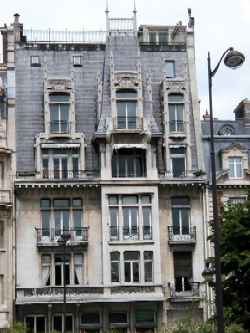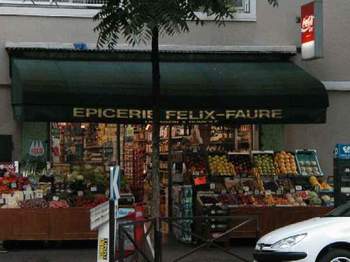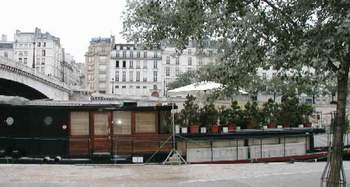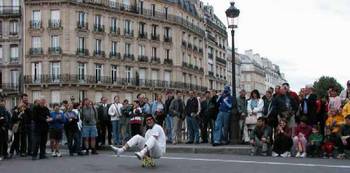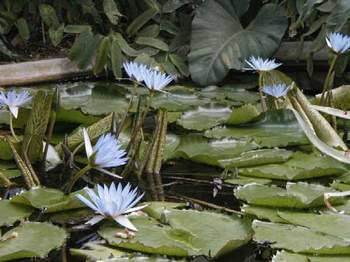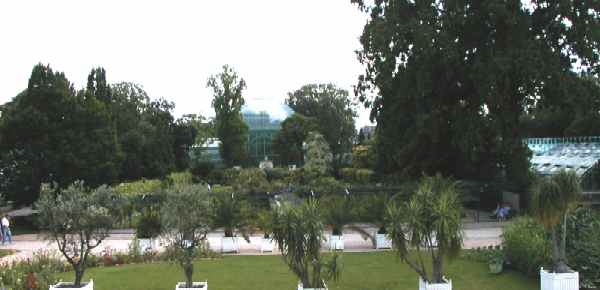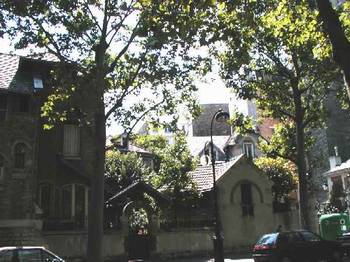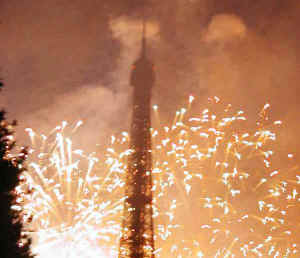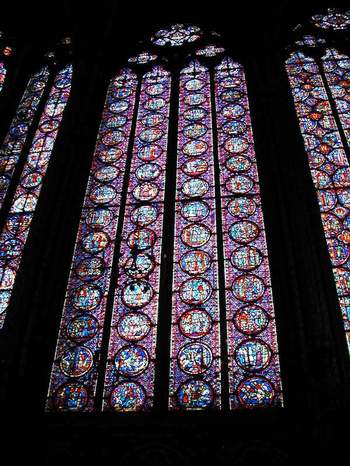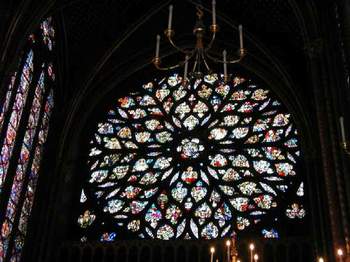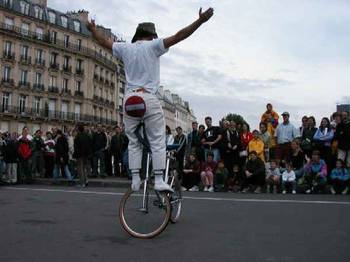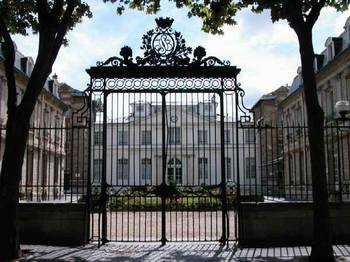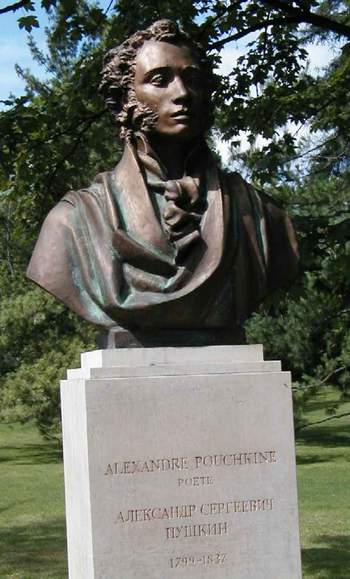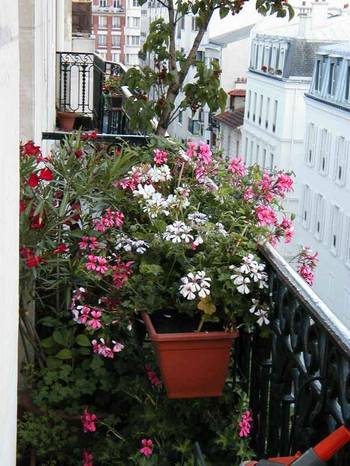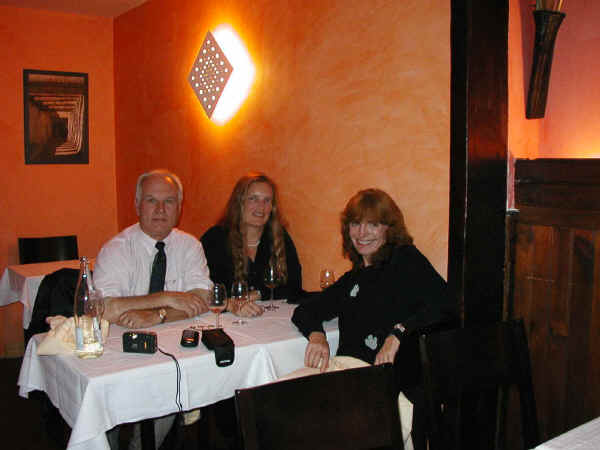 Tuesday, July 24Our friend, Wendy, came to visit us for Bastille day weekend. Wendy, who was visiting family in England, was a good sport considering the weather, which was miserably wet and cool all weekend. Fortunately it stopped raining yesterday afternoon and we were able to watch the Bastille day fireworks last night on the Champ de Mars. Like last year, it was shoulder-to-shoulder through the entire park, and everyone had a great time and everyone was very polite -- no crazy drunks.
On Friday, after Wendy's arrival we went to Notre Dame and then wandered around a bit in the Latin Quarter, taking in the churches of St. Julien le Pauvre, St. Severin, and St. Germain des Pres. Wendy wanted to stop for coffee and a snack at a creperie on rue de la Harpe, and it turned out to be a place we'd been before. We were even given the same table as before. Strange. We were soaked by the time we got back to the apartment, so we changed and went to the "bal." The firefighters in each arrondissement sponsor a street party on the eve of Bastille Day. Our neighborhood's party was on Parc Violet, where the fire station is located. There were mostly young working people there, but there were a few other middle agers like us, and we had a good time. I danced up a storm. Wendy and I each had a glass of champagne, which the firefighters were serving for a mere 30 francs (less than $4) each. On Saturday, we saw Sainte Chapelle with its lovely stained glass (done by the same artisans who created the windows at Chartres). We also took in the Palais's Conciergerie, the notorious prison where the Revolution housed people before they were executed. Over 2,000 people were killed -- not all aristocrats. Some were ordinary peasants, farmers, and grocers. There is even a list of names on display in one room. The exhibits made it very clear what kind of condition the cells were in. Those who could afford to pay had nicer cells, of course. The poorest slept in hay on the floor of large rooms with many others. Marie Antoinette was there for two months. She had nice accommodations, and even had her own chapel.
Glass at Sainte Chapelle.
We encountered a very funny street performer, a comedian bicyclist. Tom and I saw him last year or the year before, too. He had attracted a big crowd near Notre Dame, and he kept us thoroughly entertained for almost a half hour. The sign on the seat of his pants is a common street sign used to signal "no entry" to keep drivers from going the wrong way on one-way streets.
Chateau on rue d'Auteuil, now being used as a school.
Le professeur is proud to discover the dead poets' square.
The great poet Pushkin, one of our cat's favorite human writers.
When we return from a day of adventures, we sit on the balcony and watch the balloon in the Parc Andre Citroen go up and down, loaded with tourists.
More flowers on our balcony. Tuesday, July 24We learned last year that buying train tickets to another country can be a real bureaucratic hassle in Paris. When you do this at a train station, you must go to a carpeted room that has 4 or 5 young bureaucrats seated at desks. The edges of the room have some chairs where commoners (what we call customers) sit and wait after they take a number from the little number dispensing machine. Somewhere near the top of the room is a digital box that displays the number of the most recent commoner to be tended to. There is always a very long wait for the commoners. Finally, when a commoner's number is called, the commoner is allowed to approach a bureaucrat's desk and to sit meekly on the other side of it. Then the commoner pleads with the bureaucrat until finally, after much discussion and many questions, the bureaucrat sells the train ticket to the commoner. We thought we'd escape this experience by buying our tickets to England via the SNCF web site, and we learned then that while we could have them delivered, it was probably too risky since it was only 4 days before our trip and the delivery address would not match our credit card billing address. But, we learned from the web site, we could pick up the tickets we just purchased at any SNCF shop or SNCF agent. We looked in the phone book for a listing of these shops, but could not find them. We reasoned that surely we'd see an SNCF shop or agent on one of our walks. Sure enough, on Sunday we saw an SNCF boutique at the Porte d'Auteuil. It was closed, of course, but we were able to check out the hours of operation and we knew it was a very easy Métro ride to get there. Yesterday, we went there only to find that it is a large carpeted room just exactly like the one described above. We took a number. About 50 people were ahead of us. But we knew the score -- it would be a very long wait. So we left and finished the walking tour of Auteuil that we were too tired to finish on Sunday. We saw charming "hameaux" (hamlets) in this lower part of the 16th arrondissement. They are like private villages, with winding little streets, and they are walled off from the city. One of the hameaux, called Boileau, was open to us. It was charming, but impossible to capture on camera. Sorry. Upon leaving this hameau, we saw a delightful cluster of buildings designed by Emile Guimard (by now our favorite Parisian architect). Here are some pictures of these at left. We arrived back at the SNCF boutique before our number had been called. One of the young bureaucrats was arguing with a very old commoner, a man who had just decided he would ask for a ticket on the direct train to Montpelier, one that passes through a particular piece of countryside, whether or not that train still existed. The young female bureaucrat was explaining, for the twentieth time, that this train no longer exists. He could either take a different direct train, or he could take one that made several stops. He kept insisting, until he brought her almost to the edge, to the point where she was about to lose control. Then he'd back down a little, and they'd start up again. This went on for about 15 minutes. Finally, she sold him a ticket for the other direct train. On his way out, the elderly commoner chose Tom as someone who would listen to his side of the story. He went on at some length, all in French of course, without any idea that Tom and I were only picking up a fraction of what he was saying. It didn't matter. He just kept talking. Finally, Tom responded empathetically by saying, "Oui, c'est trés difficile." The elderly commoner was happy with that, and bid Tom a good day. Then he was gone. The rest of the wait was boring, but not too long. We'd succeeded in outwitting the bureaucracy, we thought, because we did not have to suffer for too long. When we finally were called to approach a bureaucrat's desk, I was prepared and explained in French that we'd already bought our tickets on the web and we needed only to pick them up. It was fast and easy from that point on. We got our tickets!!! She even checked to see if she could sell us the tickets we'd need in London in order to reach the town near Oxford where we are going -- Princes Risboro. Unfortunately, she could not. We'll have to buy those when we get there. We celebrated our victory by having a nice lunch at a little restaurant on rue Poussin. We picked the place after carefully scrutinizing about four or five places nearby. It turned out to be an excellent choice. (Escrouzailles, 37 rue Poussin, 75016) Tom's duck tasted like a fine beef steak (!) and mine (a different preparation) was also excellent. This was slightly country fare, and was hearty enough that we didn't need to eat dinner later. In the evening, we just had some heavenly cheese & baguette on the balcony. After lunch we decided to take an ordinary city bus ride -- our first ever in Paris. It is easier to take the bus after you know the streets of Paris fairly well, because the drivers don't call out the names of the stops, and you have to have a good idea of where you are so you know when to disembark. In this case, we decided to take the number 52 all the way to the end of the line, in the middle of the city near l'Opéra. This bus travels along some of the most famous boulevards, including the ave. Victor Hugo, boulevard Haussmann and the rue Faubourg St. Honoré. The grand buildings and monuments go by at a dizzying pace -- I'm accustomed to seeing them by walking. |
